Fall is fast approaching, and already we’re thinking about spring!
With the vegetable gardens under way, the orchard planted out and irrigated, it’s time to turn our attention toward the native wildflower species that we’d like to see growing here come spring.
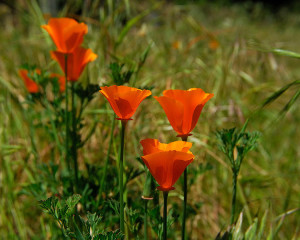
California poppies are beautiful, but we'd like to see a wider array of native wildflowers blooming here next spring
Rather than plant the orchard out with typical commercial cover crop species, most of which are non-native, and some of which are rather invasive, our plan for the orchard is to bring a diverse array of California’s native wildflowers to our orchard slopes instead.
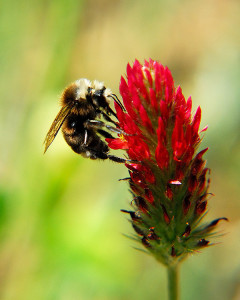
Crimson clover is a beautiful, widely planted, cover crop species in California's orchards, and vineyards, but often escapes cultivation, becoming locally invasive in some areas
After last year’s clearing, and the planting in spring, the slope became home to a number pervasive, and undesirable weed species this season. However, distracted with other tasks, little weeding was done, and we also discovered a few natives growing too. We’ve endeavored this year to focus on watching what grows here of its own accord, friend or foe, before beginning work on the more aesthetic components of the garden.
Although we purchased some wildflower seeds last year, we opted to hold off on seeding the orchard while we tried to inventory as many native species on the property as possible, and identify the worst of the invasive thugs and remove them. We’re winning some battles, like the broom patch along the road, and losing others, primarily due to our own error, such as cutting down some bull thistles, inadvertently forcing them to bloom a year earlier than they should have. Live and learn!
Now that we have a better handle on what to pull, when to pull it, and what not to pull in the orchard, the nature of our soils, sun exposure, watering needs, and wildlife pressures, it’s time to acquire the additional species we want to add to the property, as fall, for California annual wildflowers at least, is the best time to plant seed, as our seasonal rains are (hopefully) just around the corner.
We’re electing to seed as many natives as possible, rather than purchase plugs or transplants, because we literally have a lot of ground to cover. Seed is simply the most economical route. Before we can plant though, we first have to decide which species would be most appropriate here.
We first had to ask ourselves what sort of gardeners we desired to be. Do we want to be purely habitat restorationists, purists? If so, then those plants that are endemic to this watershed will dictate the group from which we can select plants.
Alternatively, could we focus on planting regionally native plants, those native to Santa Cruz county, even if they were not historically present on this property? This would certainly afford us a wider variety of species to choose from.
What about plants not native to this region, but native to other parts of California, that are adapted to our climate?
New to native gardening, I honestly had purist intentions, but I’ve already broken a few of those rules, and I expect I’ll break a few more before we’re done here. I suffer from a syndrome akin to that which magpies are afflicted with, except instead of absconding with shiny objects, I’m attracted to colorful ones, usually while I’m on a mission for ‘just one thing’ at a local nursery. Invariably, I leave with half a dozen things I had no idea I ‘needed’. To my credit though, 99% of the time, they are at least regionally native. The majority of natives we intend to plant here will be either endemic to the property, or at least regionally native to Santa Cruz. However, as explained below, a few adapted, but well behaved natives from outside the region may occasionally find their way here.
As we are endeavoring to preserve the endemic natives here, we’re intending to propagate some of them from seed collected during the year, including Ceanothus thyrsiflorus, Calochortus albus, and Lonicera hispidula.
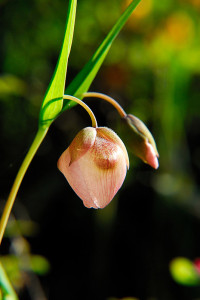
We collected numerous seeds from the endemic Calochortus albus plants here this summer, and hope we can propagate at least a few from seed
Despite finding numerous native species here this year, overall, with the exception of the Sticky Monkeyflowers (Diplacus aurantiacus ssp. aurantiacus), the palette throughout most of the property is rather…well…green, and a bit dull.
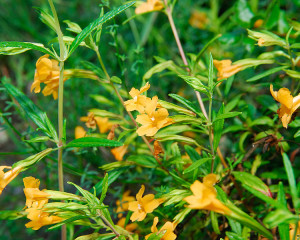
Sticky Monkeyflower is endemic to the property, and the showiest of the native wildflowers present here
Not that green is drab, but I have found myself yearning for more pizazz throughout the year here. We have a lot of structural natives here already, we’re just lacking a little zing. Some of that pizazz will come from encouraging those species already here to increase in number, but it seems even then, we may still be a little lacking. This year, in regards to mass and scale, our squash blossoms in the vegetable garden probably had the most ‘wow’ factor.
To address this, we’ve spent some time researching which species at least are native to Santa Cruz county. Of those, we then needed to determine which were readily available in seed form (many it seemed were not). With the list narrowed, we had to consider which color palette, if any, we wanted to work with first, and of the plants within that palette, which were best suited to the areas we wish to plant.
I should clarify, we’re not planting in the natural woodland areas of the property, just the small cultivated areas, targeting the orchard, and the exposed dry, sandy slope, directly above the gardens. Plants tolerant of occasional water will be sown through the orchard, but those not requiring supplemental irrigation once established will be grown outside of the irrigated areas. The true woodland areas will be either left alone, or only species already there will be propagated for those areas, and the thugs will continue to be removed.
So, after whittling down the list of the regionally appropriate native species, we’ve narrowed our choices down to:
Goldfields (Lasthenia glabrata): Annual. Native to Santa Cruz County. This plant bears tiny bright-yellow flowers, forming a sunny backdrop for other California native flowers. This plant is one of the primary nectar food sources for the Checkerspot butterfly. The fine seed attracts goldfinches, and planted en masse, apparently has a beautiful scent.
Sky Lupine (Lupinus nanus): Annual. Native to Santa Cruz County. Choosing a lupine was challenging, as they’re all quite beautiful. This is a low-growing annual species, blue and white in color, that blends beautifully with California poppies, without dwarfing them. This lupine is also a food plant for American Lady butterfly.
California Poppies (Eschscholzia californica): Annual. Native to Santa Cruz County. We already have a few growing outside the orchard fence, that are systematically mowed down by the deer when they bloom. We’re going to try a few inside the fence for us to enjoy instead.
Blue-Eyed Grass (Sisyrinchium bellum): Perennial. Native to Santa Cruz County. This was one of my magpie moments in a local garden center. After purchasing a single plant, it simply wasn’t enough. Hopefully we’ll be able to propagate this species successfully from seed.
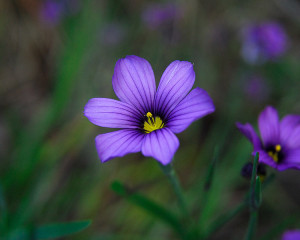
We currently have one Blue-Eyed grass plant, but with more seed on the way, we hope to have much more of this on the slope next spring
As it tolerates moisture this plant will be better situated near the irrigated areas of the orchard, scattered among the Goldfields and poppies.
These first four species will form the floral backbone of the main orchard slope.
Globe Gilia (Gilia capitata): Annual. Native to Santa Cruz County. This plant thrives on dry banks in its native environment, and has a long bloom period, self-sowing freely once established.
Tidy Tips (Layia platyglossa): Annual. Native to Santa Cruz County. Daisy-like yellow flowers with white tips, similar in habit to Goldfields, blooming from March to June. Nectar source for the Checkerspot butterfly.
Gilia, and Layia are destined up-slope of the gardens, where the soil is less rich, and very dry. These plants will help to extend the base yellow-blue color palette in the orchard further up slope.
Next spring, in addition to our resident native pollinators and Mason Bees, we’ll be adding European honeybee hives to the property to help improve pollination in the gardens and orchard. As such, we need to be mindful that in our mild climate bees are more active here than in colder northern climes, during periods of a relative dearth of blooms. Some of the following, although native to California, aren’t necessarily native to Santa Cruz county, but should be well enough behaved, that they shouldn’t pose a threat to native flora and fauna that is resident here. Primarily with the honeybees in mind, we’re also planting the following:
Bee Plant (Scrophularia californica): Perennial. Native to Santa Cruz County. Well, it’s a bee plant, how could we not?!? We actually already have one growing here, acquired earlier this year, but most of it was mowed down by some Checkerspot butterfly larvae earlier this season (hence no photo), so clearly we need to plant a few more!
Coast Buckwheat (Eriogonum latifolium): Perennial. Native to Santa Cruz County. Bees apparently make a phenomenal honey from buckwheat, and along with some sage, is one of the few plants blooming in mid-September.
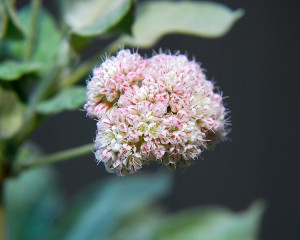
Coast buckwheat is still blooming here in mid-September. Planting more will ensure our bees next year have some wildflowers blooming during late summer
Honey flavor aside, these plants should help to provide a nectar source in the late season when little else is in bloom. Coast buckwheat is also a food plant for the native Mormon Metalmark butterfly (Apodemia mormo).
Rosy Buckwheat (Eriogonum latifolium grande var. rubescens): Perennial. NOT native to Santa Cruz County. Native to California’s Channel Islands.
Rosy Buckwheat is reportedly easy to grow from seed, and a late season bloomer. The two plants gifted to us by Christine from Idora Design are thriving, but we’d like to grow a lot more.
Cleveland Sage – (Salvia clevelandii) – NOT native to Santa Cruz County. This was my first non-watershed appropriate native plant purchase, proving I’m not a purist native gardener, specifically the ‘Winnifred Gilman’ cultivar, and unless she proves unruly she’s here to stay!
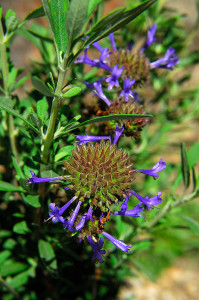
S. clevelandii 'Winnifred Gilman' is still blooming in late summer, and highly attractive to bees and hummingbirds
Sadly, this hybrid sage cultivar is not readily available in seed form, but a few transplants were recently obtained and incorporated into our gardens.
Purple Flowering Sage (Salvia leucophylla) – NOT native to Santa Cruz County. This sage cultivar is easily obtainable in seed form, and thrives in dry environments. Similar in appearance to S. clevelandii above.
These are the native plants that we’ve just placed a seed order for, and will focus on planting throughout the upcoming fall and winter season. Our plan is not to plant a formal arrangement of plants, but to attempt to mimic more of an informal native meadow planting with the annual wildflowers, and plant the perennial shrubs around the periphery of the gardens. We still need to source seed for some low-growing native California grasses to blend with the annual wildflowers to help complete the meadow-like effect. If all goes well on the seed propagation front this fall though, the slopes should look anything but drab come spring.
If you’re planning to plant native California wildflowers for the spring from seed, and there are many more than the few listed here, now is the time to start planning, as the sowing season commences as soon as our seasonal rains return.

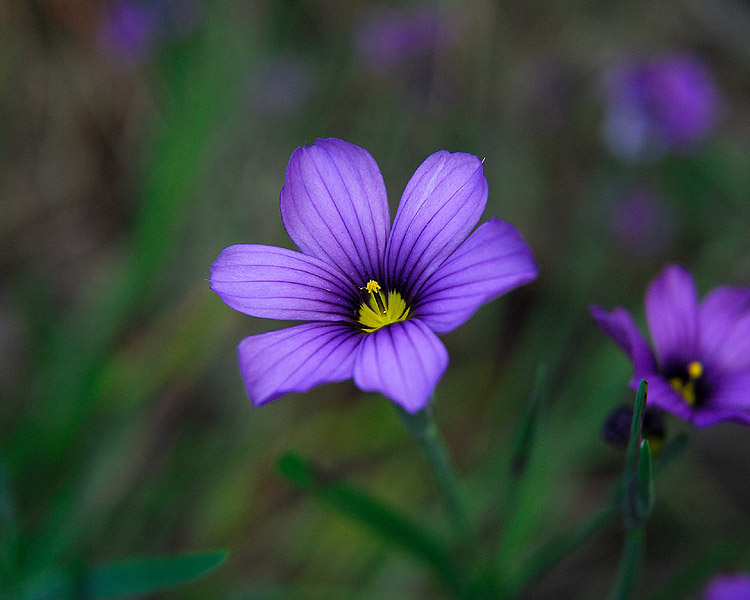
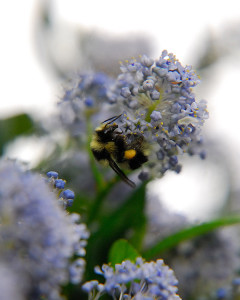
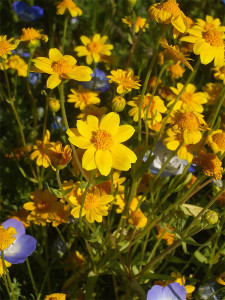
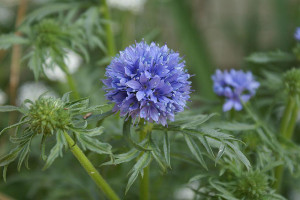
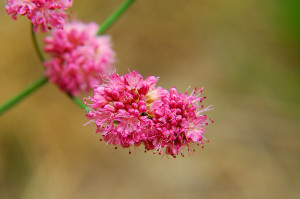







Wow, it looks like you have really done your research. Your orchard will look beautiful!! I’m sure the bees and butterflies will appreciate all your hard work!
Love these picks! I’m going to attempt rosy buckwheat in a dry, neglected part of the yard.
This is so exciting! I love native plants, the philosophy and science behind planting them makes sense! And, I get to learn about the beauties California has to offer~Who knows maybe I will finally convince my spouse to move there~gail
Oh Gail, don’t move…not that we wouldn’t welcome you here, but your garden is gorgeous! How could you leave?
Great choices! I myself, living in the suburbs, am of course no purist, but I do think it’s probably fine to plant non-invasive climate-appropriate plants. Or maybe even some that need extra water, to get that greenbelt effect around the house. I can just see all the color you’ll get next year.
(BTW, do you know Native Revival has a big sale coming up weekend after next? )
We’re certainly hoping for color…depends somewhat on what sprouts!
Don’t now how I missed the Native Revival sale. My sale ‘radar’ must be broken 😛 Now scribbled, in pen, in my calendar…thanks!!! Wouldn’t miss it, I love it there!
One more thing. I would avoid Eriogonum giganteum. It can easily be 8 feet by 8 feet, there’s a plant in the Don Edwards educational center garden (Alviso). Eriogonum arborescens is more well behaved, usually stops at 4 feet.
Dear Clare, I am filled with admiration at the way in which you research native species and then carefully consider how you may use them on the farm, separating in your mind the natural woodland areas from those, like the orchard, which could be termed ‘cultivated’. And who would not forgive your wanting just that extra bit of colour? Green, of course, in all shades being one!!
When I read your title Claire I knew it would be a great post … ’twas right! Fabulous selections. With all my invasive plants I could never grow these delicate choices. I cannot wait to see what your orchard and slope will become. ;>)
So there are Channel Islands in California? I was wondering about that? You inspire me to rethink what we plant under our handful of trees. The planning takes almost as much time as the weeding.
There are indeed Channel Islands in California. I grew up with the Channel Islands off the coast of Britain, but here we have eight islands off the coast of Southern California. Anacapa, San Miguel, Santa Cruz, Santa Rosa, San Clemente, San Nicolas, Santa Barbara, and Santa Catalina. Many of which have their own unique flora and fauna, including the lovely Rosy Buckwheat.
What a splendidlly large choice of native plants you have. Enviable indeed.
Wow! I am looking forward to photos of your wildflowers in bloom next year. I think the selections you have chosen will be wonderful together. Your place will be appreciated by people and critters alike!
I am certainly no native purist, as you can tell from my garden blog. Native plants are very difficult to find in my locale without driving a great distance to an urban area in order to find a native nursery. (Seriously, does that makes sense?) Furthermore, it is illegal to collect plants from public lands or private property without permission. The few natives I do grow in my garden were collected by me from my son’s property or passed along by a close relative. (Of course, in that case, it’s a “don’t ask, don’t tell, just take” policy.)
BTW, your natives are beautiful!
What a great post! California gardeners can find such valuable information here! You certainly do your homework! Good luck with those beautiful natives! Thank you for your comment on my post! I also think that deers will get used to my Scarecrow earlier or later. Well, then I can become a member of NRA… Joking…I can’t kill even a bug. (Well, actually I can if I need).
You aren’t messing around are you? Great choices all around. The Calochortus is beautiful. That’s so great you were able to collect seeds.
As for goldfields I haven’t noticed the scent, but I saw fields and fields of them in Henry Coe State Park and they are really nice. And sky lupine is one of my favorites.
Wow. Well-researched with great spirit, heart and intellect. May your plantings be as healthy as your plannings.
I love your flower choices. I’m wondering how these new plants will be located in your orchard. When you have to pick fruit from trees will you be treading on your new plants? We are attempting to renovate an old orchard and have been considering this question ourselves so I’m very curious how others are approaching this issue.
We have a few somewhat defined paths through the orchard, in part because some of the slope is difficult to walk on. A few our wildflowers will probably get stepped on here and there, but overall we’ll stick to the pathway areas through the orchard. We won’t be seeding within the drip line of the trees though, as this provides hiding areas for voles, and will increase root competition with the trees. We’ll likely use a light gravel mulch within the drip lines.
My honey bees totally ignored the scrophularia. Goodness knows why. It’s not the most attractive plant, and it’s a bit of a thug, so I may move it.
Actually, my bees do very little foraging in my yard, which is vexing on one hand, and kind of great on the other. Our yard is midget-ine, so it wold be challenging to sit outside if all the bees hung out here all the time.
Nice choices! (I’ve got about half of what you’ve mentioned somewhere in my garden.)
I really enjoyed this post, Clare, and I can’t wait to see which wildflower seeds you ultimately decide to sow and the resulting blooms next spring. I’ve struggled with the “to be or not to be a purist” quandary when I first started revegetating some of the bare and weed-infested parts of our property. I too have a proclivity towards the more colorful and showy natives which aren’t necessarily found in our region. So, I’ve compromised over the years and now have a rather eclectic garden with natives from throughout the State (taking care to choose from those that aren’t known to hop the garden and become potentially invasive) interspersed with drought tolerant Mediterranean varieties. The annuals I sow from seed include Cal Poppies, Baby Blue Eyes, Five Spot, Globe Gilia, Tidy Tips and assorted Clarkias. Look forward to reading more of your wildflower posts!
I’m so excited to see the quilt of flowers on your property, Clare! Have you considered using the Coastal form of CA poppy? Yellow with an orange heart- so lovely. Also, can’t be sure, but I thought Scrophularia was geared more towards the Bumbles… Still worthwhile if it’s bringing the butterflies!
And please let me give you more Red Buckwheat! They reseed like crazy and I haven’t even watered them!
We would love more of the red buckwheat! Larner cancelled our Rosy Buckwheat because their blossoms were coming out too pale this spring. Another nursery this weekend said they pulled theirs for the same reason, so we haven’t been able to source seed 🙁 I do wonder though if perhaps the color variation has more to do with our aberrant cool weather this summer. I did get some Eriogonum latifolium…just came up empty handed on the lovely red buckwheat. Be happy to trade some Salvia, or yarrow, or (if it germinates) Western columbine! 😛